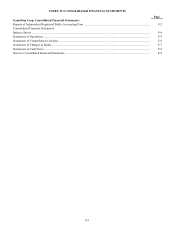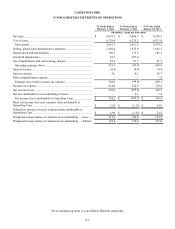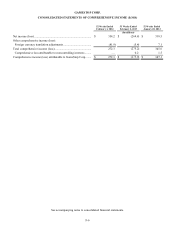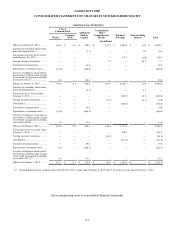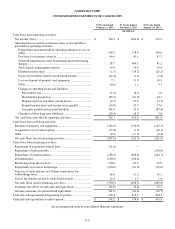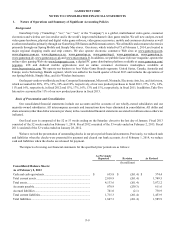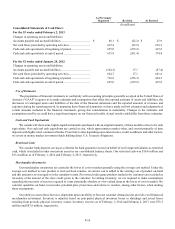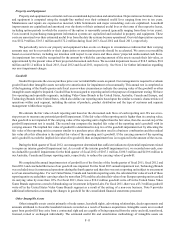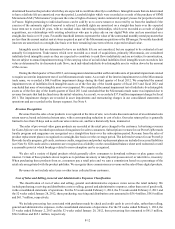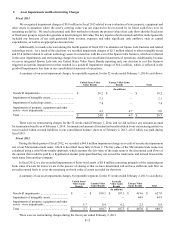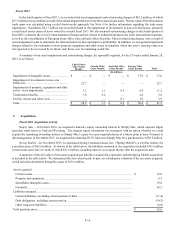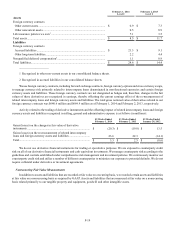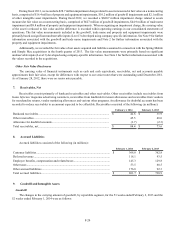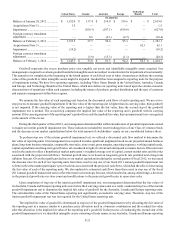GameStop 2013 Annual Report Download - page 84
Download and view the complete annual report
Please find page 84 of the 2013 GameStop annual report below. You can navigate through the pages in the report by either clicking on the pages listed below, or by using the keyword search tool below to find specific information within the annual report.F-11
Property and Equipment
Property and equipment are carried at cost less accumulated depreciation and amortization. Depreciation on furniture, fixtures
and equipment is computed using the straight-line method over their estimated useful lives ranging from two to ten years.
Maintenance and repairs are expensed as incurred, while betterments and major remodeling costs are capitalized. Leasehold
improvements are capitalized and amortized over the shorter of their estimated useful lives or the terms of the respective leases,
including option periods in which the exercise of the option is reasonably assured (generally ranging from three to ten years).
Costs incurred in purchasing management information systems are capitalized and included in property and equipment. These
costs are amortized over their estimated useful lives from the date the systems become operational. Our total depreciation expense
was $152.9 million, $163.1 million and $172.2 million during fiscal 2013, fiscal 2012 and fiscal 2011, respectively.
We periodically review our property and equipment when events or changes in circumstances indicate that their carrying
amounts may not be recoverable or their depreciation or amortization periods should be accelerated. We assess recoverability
based on several factors, including our intention with respect to our stores and those stores’ projected undiscounted cash flows.
An impairment loss would be recognized for the amount by which the carrying amount of the assets exceeds their fair value, as
approximated by the present value of their projected discounted cash flows. We recorded impairment losses of $18.5 million, $8.8
million and $11.2 million in fiscal 2013, fiscal 2012 and fiscal 2011, respectively. See Note 2 for further information regarding
our asset impairment charges.
Goodwill
Goodwill represents the excess purchase price over net identifiable assets acquired. Our management is required to evaluate
goodwill and other intangible assets not subject to amortization for impairment at least annually. This annual test is completed as
of the beginning of the fourth quarter each fiscal year or when circumstances indicate the carrying value of the goodwill or other
intangible assets might be impaired. Goodwill has been assigned to reporting units for the purpose of impairment testing. We have
five operating and reportable segments, including Video Game Brands in the United States, Australia, Canada and Europe, and
Technology Brands in the United States, which also define our reporting units based upon the similar economic characteristics of
operations within each segment, including the nature of products, product distribution and the type of customer and separate
management within those regions.
We estimate the fair value of each reporting unit based on the discounted cash flows of each reporting unit. We use a two-
step process to measure any potential goodwill impairment. If the fair value of the reporting unit is higher than its carrying value,
then goodwill is not impaired. If the carrying value of the reporting unit is higher than the fair value, then the second step of the
goodwill impairment test is needed. The second step compares the implied fair value of the reporting unit’s goodwill with its
carrying amount. The implied fair value of goodwill is determined in step two of the goodwill impairment test by allocating the
fair value of the reporting unit in a manner similar to a purchase price allocation used in a business combination and the residual
fair value after this allocation is the implied fair value of the reporting unit’s goodwill. If the carrying amount of the reporting
unit’s goodwill exceeds the implied fair value of its goodwill, then an impairment loss is recognized in the amount of the excess.
During the third quarter of fiscal 2012, our management determined that sufficient indicators of potential impairment existed
to require an interim goodwill impairment test. As a result of the interim goodwill impairment test, we recorded non-cash, non-
tax deductible goodwill impairments for the third quarter of fiscal 2012 of $107.1 million, $100.3 million and $419.6 million in
our Australia, Canada and Europe reporting units, respectively, to reduce the carrying value of goodwill.
We completed the annual impairment test of goodwill as of the first day of the fourth quarter of fiscal 2011, fiscal 2012 and
fiscal 2013 and concluded that none of our goodwill was impaired. For the fiscal 2013 annual impairment test, Technology Brands
was excluded since it commenced operations during the fourth quarter and therefore was not a reporting unit subject to assessment
as of our annual testing date. For our United States, Canada and Australia reporting units, the calculated fair value of each of these
reporting units exceeded their carrying values by more than 20% and the calculated fair value of our Europe reporting unit exceeded
its carrying value by more than 10%. For fiscal 2013, there was a $10.2 million goodwill write-off in the United States Video
Game Brands segment as a result of abandoning our investment in Spawn Labs. For fiscal 2011, there was a $3.3 million goodwill
write-off in the United States Video Game Brands segment as a result of the exiting of a non-core business. Note 9 provides
additional information concerning the changes in goodwill for the consolidated financial statements presented.
Other Intangible Assets
Other intangible assets consist primarily of trade names, leasehold rights, advertising relationships, dealer agreements and
amounts attributed to favorable leasehold interests recorded as a result of business acquisitions. Intangible assets are recorded
apart from goodwill if they arise from a contractual right and are capable of being separated from the entity and sold, transferred,
licensed, rented or exchanged individually. The estimated useful life and amortization methodology of intangible assets are


